All About Cobalt, Cornflower and Soft Blue Sea Glass
Bring on the Blues… Blue Sea Glass that Is
 Perhaps the most celebrated of all sea glass jewels are the true blues – cobalt, cornflower and soft blue sea glass has enthralled beach goers for over a century. Neither the green of seafoam, or a member of the aqua family of sea glass, true blue is a hands-down favorite among sea glass lovers.
Perhaps the most celebrated of all sea glass jewels are the true blues – cobalt, cornflower and soft blue sea glass has enthralled beach goers for over a century. Neither the green of seafoam, or a member of the aqua family of sea glass, true blue is a hands-down favorite among sea glass lovers.
Cobalt, a bright blue mineral, is the colorant in true blue sea glass. Cobalt oxide to be exact. Other forms of cobalt are used to create vibrant turquoise or violet blue purples. Because Cobalt oxide is relatively easy to use in the glass making process, bright blue bottles with consistent color have been made for hundreds of years. Although rare, cobalt blue sea glass is quickly spotted on the shoreline, making it much easier to find than it’s sea glass sister, cornflower blue. Cornflower blue sea glass comes from bottles and tableware with limited amounts of cobalt oxide added to the glass mixture. Far fewer cornflower blue items were manufactured, making finding this color about twice as rare… and its paler shade makes it much harder to see.
Although rare, cobalt blue sea glass is quickly spotted on the shoreline, making it much easier to find than it’s sea glass sister, cornflower blue. Cornflower blue sea glass comes from bottles and tableware with limited amounts of cobalt oxide added to the glass mixture. Far fewer cornflower blue items were manufactured, making finding this color about twice as rare… and its paler shade makes it much harder to see.
On the far end of the true blue scale is soft, or ice blue. Think of the famous Ball canning jars of the early to mid 1900s… ink bottles, fruit jars and patent medicine bottles were all made in soft blue. Each of these vessels give us that soft, glowing soft blue sea glass that just says “vintage.”
All about Cobalt and Cornflower Sea Glass
 We’re not the first generation to love cobalt blue glass. Ancient Egyptians and Mesopotamians were crazy about the color too… King Tut’s gold death mask has inlaid cobalt glass, and Danish researchers have found cobalt blue beads in a wealthy woman’s grave from the period that were made in the same workshop as Tut’s glass!
We’re not the first generation to love cobalt blue glass. Ancient Egyptians and Mesopotamians were crazy about the color too… King Tut’s gold death mask has inlaid cobalt glass, and Danish researchers have found cobalt blue beads in a wealthy woman’s grave from the period that were made in the same workshop as Tut’s glass!
In the ancient world, long before speedy trade routes had been established, cobalt blue glass was valued to the point that it traveled from Egypt to Denmark! Cobalt blue glass was a luxury material for thousands of years before technology developed to make its production easier.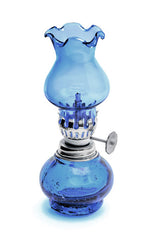 In the late 1700s, cobalt blue glass told the world that the owner was prosperous, and blue glass began to be made in more decorative and household forms. The center of this production was in Bristol, England, where over 15 glassworks began to produce striking blue glass tableware and decorative objects for wealthy customers, including royal families throughout Europe.
In the late 1700s, cobalt blue glass told the world that the owner was prosperous, and blue glass began to be made in more decorative and household forms. The center of this production was in Bristol, England, where over 15 glassworks began to produce striking blue glass tableware and decorative objects for wealthy customers, including royal families throughout Europe.
By the 1860s, cobalt blue glass, and its lesser used sister cornflower blue glass, were used primarily for utilitarian bottles, especially medicine and poison bottles. 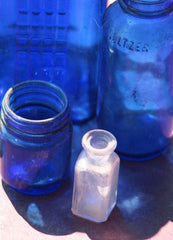 And with the dawn of the 20th century, mass production of blue bottles for Bromo-Seltzer - a common drug marketed as a remedy for headaches, stomach upset and general malaise - began. Packaged in an intensely colored cobalt bottle, the medicine was first produced in 1888, and the company used their distinctive cobalt glass bottles until the 1950s. Vicks Vapor Rub and Noxema also used bright cobalt blue glass jars into the 1950s.
And with the dawn of the 20th century, mass production of blue bottles for Bromo-Seltzer - a common drug marketed as a remedy for headaches, stomach upset and general malaise - began. Packaged in an intensely colored cobalt bottle, the medicine was first produced in 1888, and the company used their distinctive cobalt glass bottles until the 1950s. Vicks Vapor Rub and Noxema also used bright cobalt blue glass jars into the 1950s.
The Hazel Atlas Glass Company created cobalt blue glass in the Depression era. One of the company’s most famous creations was the Shirley Temple mug and tableware collection, which had a decal of the child actress on it. Hazel Atlas went on to make the coveted Moderntone and Royal Lace patterns from the same color glass.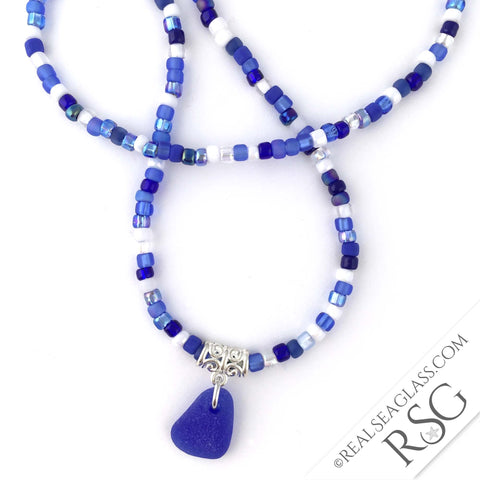 Meanwhile, the less commonly used cornflower blue glass enjoyed popularity in the 1920s and through the Great Depression. Used by Phillips for their famed Milk of Magnesia bottles, cornflower blue glass was also a late color entrant in the Depression glass craze – where this softer cobalt hue became popular for the pressed glass tableware produced from 1930 - 1950.
Meanwhile, the less commonly used cornflower blue glass enjoyed popularity in the 1920s and through the Great Depression. Used by Phillips for their famed Milk of Magnesia bottles, cornflower blue glass was also a late color entrant in the Depression glass craze – where this softer cobalt hue became popular for the pressed glass tableware produced from 1930 - 1950.
And then… the 1960s and plastic. With the development and spread of plastic as a cheap, easily produced and transported packaging alternative, glass production in all colors, but especially the expensive cobalt and cornflower blues dropped almost overnight.
Perhaps this in one of the reasons why cobalt and cornflower blue sea glass is so immensely popular. The color of sea and sky, each small piece is full of history.
All About Soft Blue Sea Glass
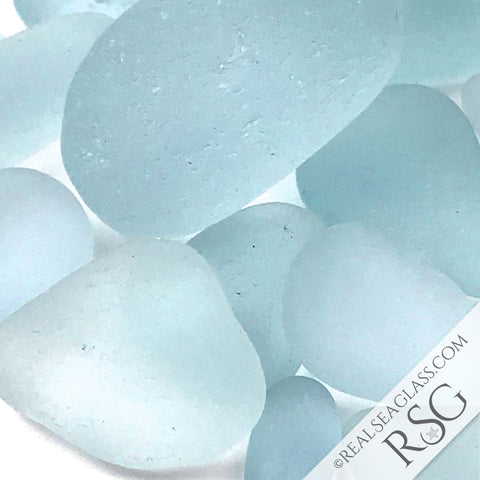 If deep cobalt blue that looks almost black is at one end of the true blue sea glass spectrum, soft blue is at the other. From just a hint of blue, to a wash of subtle color, soft blue glass has been a staple for glassmakers throughout the 1800 and 1900s – with it’s popularity peaking from the 1880s to the 1930s.
If deep cobalt blue that looks almost black is at one end of the true blue sea glass spectrum, soft blue is at the other. From just a hint of blue, to a wash of subtle color, soft blue glass has been a staple for glassmakers throughout the 1800 and 1900s – with it’s popularity peaking from the 1880s to the 1930s.
Unlike the deeper blues, soft blue glass was created using copper. Undoubtedly, early soft blue glass occurred naturally due to trace amounts of copper in the sand used to make glass. But soon glassmakers began producing fruit jars, patent medicine bottles, and ink and soda bottles in the soft, pastel hue.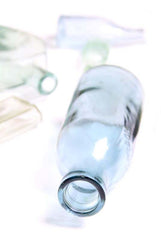 Often this glass is seeded - or what we might call bubbly – because prior to 1920, bottles were hand-blown by glassmakers. Thick, bubbly soft blue sea glass is a true treasure with a glow that reflects sunlight on the ocean.
Often this glass is seeded - or what we might call bubbly – because prior to 1920, bottles were hand-blown by glassmakers. Thick, bubbly soft blue sea glass is a true treasure with a glow that reflects sunlight on the ocean.
Thinner shards of this same soft blue may just be from windows and windshields, which often have the same blue tint as old-time bottles. Remember, soft blue, like its cornflower and cobalt cousins, is a true blue. Light aqua glass is a different color – learn more about the aqua sea glass family here> And, not to be forgotten are the glass insulators that were used throughout the country in the 1800’s through the mid-1900s. While most glass insulators were the bright green-blue aqua, there were a few that were soft blue. When these insulators began to be replaced with ceramic and composite materials in the late 1950s, linemen would often just toss the glass insulators on the ground – or into the waterway they were working next to.
And, not to be forgotten are the glass insulators that were used throughout the country in the 1800’s through the mid-1900s. While most glass insulators were the bright green-blue aqua, there were a few that were soft blue. When these insulators began to be replaced with ceramic and composite materials in the late 1950s, linemen would often just toss the glass insulators on the ground – or into the waterway they were working next to.
Insulator sea glass is an awesome find… super thick, and often with the tell-tale inner grooves that once held them onto their wooden stems, these sea glass shards have an allure all their own.
Blue Sea Glass – 5 Fascinating Facts
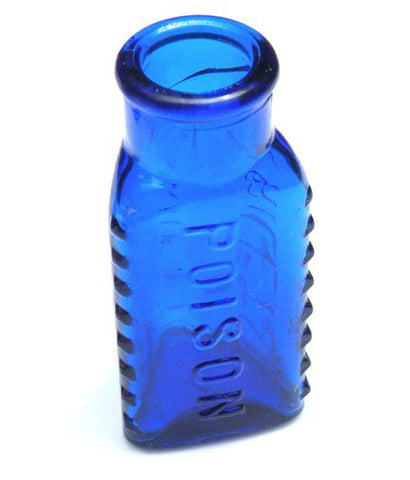 1. Throughout time, vibrant blue glass has been associates with wealth and status.
1. Throughout time, vibrant blue glass has been associates with wealth and status.
2. You can still find pieces of cornflower to cobalt blue sea glass with parts of the words “Milk of Magnesia” on them!
3. Cobalt and cornflower blue were popular colors for Victorian era poison bottles – the bottles’ bright hue and molded ribbing were meant to warn the user of the dangerous contents inside.
4. Five ounces per ton of glass is all the cobalt oxide you need to get bright blue glass – which is a good thing as it’s rather pricey.
5. Depression era blue pressed glass items are so popular, modern fakes have become as much of a problem as fake sea glass – more on that below, and for the full story on real vs. fake sea glass, click here>
Blue Sea Glass Jewelry
 Cobalt blue jewelry has been used since ancient times. In Ancient Egypt, bright cobalt lapis lazuli was used to restore calm, and encourage a connection to the wisdom of the universe.
Cobalt blue jewelry has been used since ancient times. In Ancient Egypt, bright cobalt lapis lazuli was used to restore calm, and encourage a connection to the wisdom of the universe.
Throughout time, blue has been said to protect the wearer from negative energy. The color of sea and sky, blue symbolizes truth, faith, intelligence, wisdom, loyalty and confidence.
If you are looking to tap into the natural world, reestablish tranquility and boost your intuition, put on your blue sea glass jewelry. It is held that the deeper the blue, the more profound your insights become.
How Rare is Blue Sea Glass?
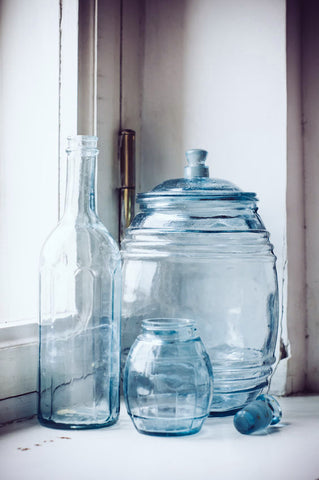 For sea glass lovers, it’s impossible to visit the beach without finding yourself staring at sand and rocks and missing the horizon altogether. And sometimes, something incredible happens. As you’re searching among the shiny, pearlescent hues of ivory and rose, or the darker rocks and bolders of a rocky beach, you spot something that seems to glow from within. Discovering piece of real blue sea glass is an extraordinary experience.
For sea glass lovers, it’s impossible to visit the beach without finding yourself staring at sand and rocks and missing the horizon altogether. And sometimes, something incredible happens. As you’re searching among the shiny, pearlescent hues of ivory and rose, or the darker rocks and bolders of a rocky beach, you spot something that seems to glow from within. Discovering piece of real blue sea glass is an extraordinary experience.
Finding a piece of natural sea glass that radiates a soft to cobalt blue aura is a true delight. Even though cobalt blue glass has been made throughout the generations, the color is still rare, especially when compared with clear or brown glass. It is thought that only about one in 250 or so pieces of real sea glass is found in a cobalt blue color, and double that for cornflower blue sea glass.
Soft blue sea glass is also rare, but not as rare as cobalt and cornflower. Don’t confuse soft blue sea glass with the greener seafoam – they are two distinct colors that share a common history.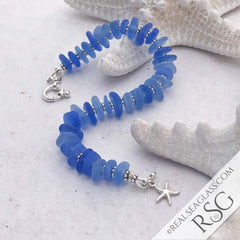 If you happen upon a vibrant to pale piece of blue sea glass on the beach, consider yourself fortunate. Those who don’t have the access or ability to comb the beach for these hidden gems can take part in the search and discovery through acquiring a piece of jewelry made with this rare genuine sea glass.
If you happen upon a vibrant to pale piece of blue sea glass on the beach, consider yourself fortunate. Those who don’t have the access or ability to comb the beach for these hidden gems can take part in the search and discovery through acquiring a piece of jewelry made with this rare genuine sea glass.
Please Note: With the rise in popularity of sea glass, cheap frosted glass labeled “Sea Glass” has appeared on the market in mass. Standard and fantasy shapes with even, shallow frosting have none of the beauty or history of surf-tumbled, hand-gathered sea glass. Authentic blue sea glass is naturally frosted by the sea, with a shape and texture created by nature over the decades, and sometime centuries. Real sea glass has a slightly uneven texture and a powdery frost that cannot be replicated. And, real sea glass has a fascinating history that makes each piece of real sea glass jewelry a true one-of-a-kind.
Authentic blue sea glass is naturally frosted by the sea, with a shape and texture created by nature over the decades, and sometime centuries. Real sea glass has a slightly uneven texture and a powdery frost that cannot be replicated. And, real sea glass has a fascinating history that makes each piece of real sea glass jewelry a true one-of-a-kind.




